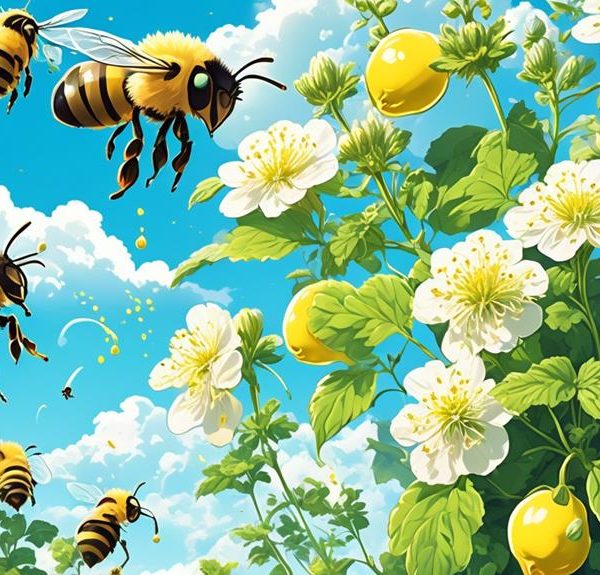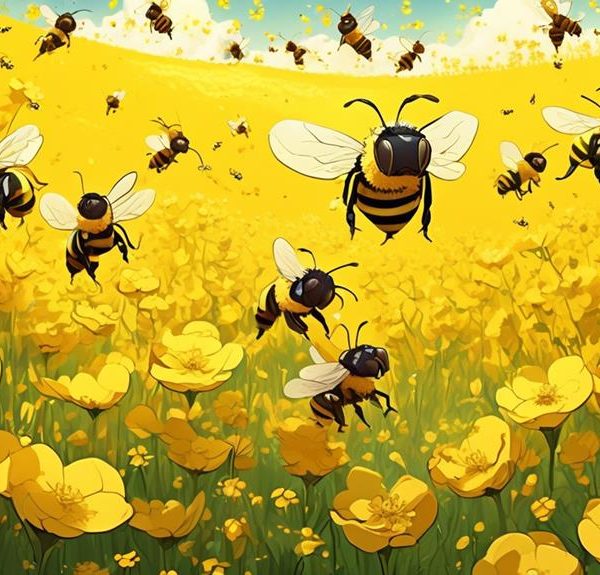Unravel the enchanting dance between bees and verbena in this exploration of floral attraction and nectar preferences.
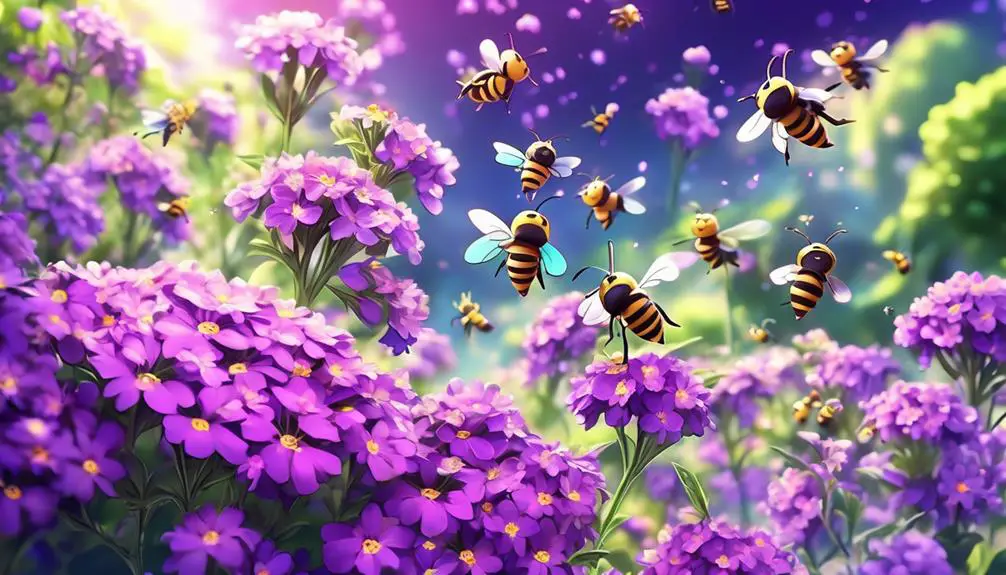
Do Bees Like Verbena?
Just as bees dance to communicate, plants too have their own ballet of attraction, and verbena seems to have a particularly tantalizing performance.
As you explore the world of bees and their floral preferences, you've likely wondered if verbena is a star in their nectar-filled universe. This vibrant, fragrant plant certainly has its allure, but does it truly bewitch our buzzing friends? Or is it merely a wallflower in the grand garden party?
Well, it's time to lift the curtain on this intriguing mystery, as we decipher whether bees perform a waltz or a quickstep away from the verbena's charming embrace.
Key Takeaways
- Verbena is attractive to bees due to its nectar-rich blossoms, vibrant purple color, and sweet scent.
- Bees are especially attracted to blue and yellow colors, which verbena flowers have.
- Verbena provides a vital food source for bees, with its rich nectar and pollen, contributing to their energy and larval development.
- Incorporating verbena in gardens, planting it in groups, and providing optimal growing conditions can enhance bee attraction.
Understanding Verbena's Appeal
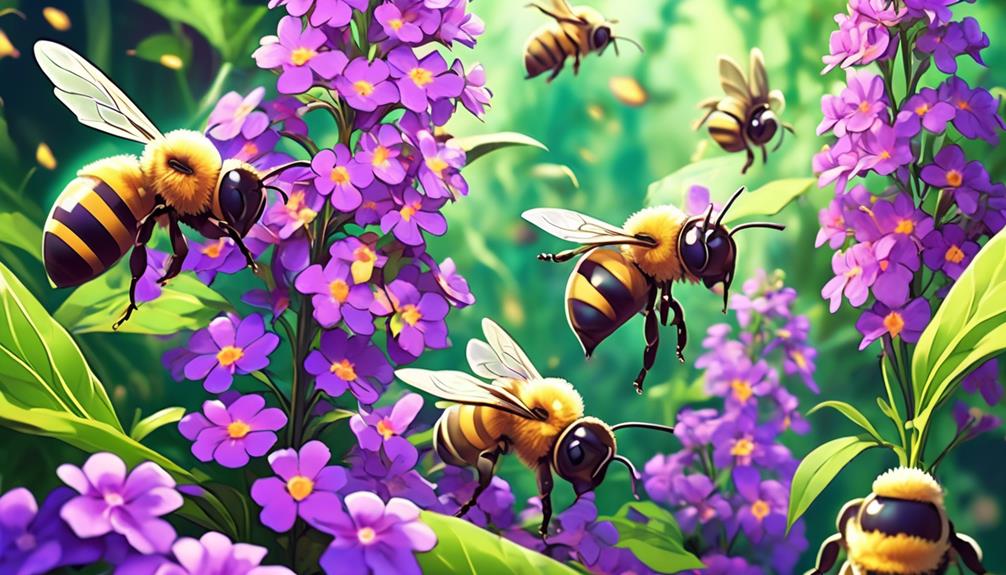
Before diving into why bees are attracted to verbena, it's crucial to understand the unique appeal of this plant species. Verbena, a genus in the family Verbenaceae, comprises around 250 species of perennial and annual flowering plants. Its widespread global distribution, coupled with its prolific bloom period, makes it a common sight in many gardens and landscapes.
You'll find that verbena's aromatic leaves and vibrant flowers, often in shades of purple, red, or white, are its primary attractions. These flowers are arranged in dense spikes or clusters, creating a visual appeal that's hard to ignore. Moreover, the plant's nectar-rich blossoms make it a magnet for pollinators, like bees.
Additionally, verbena's hardiness and drought resistance make it adaptable to a wide range of environments. It's a low-maintenance plant that thrives in full sun and well-drained soil. Verbena's resilience and easy-going nature only enhance its charm, contributing to its popularity among gardeners and landscapers alike.
Bees and Their Plant Preferences
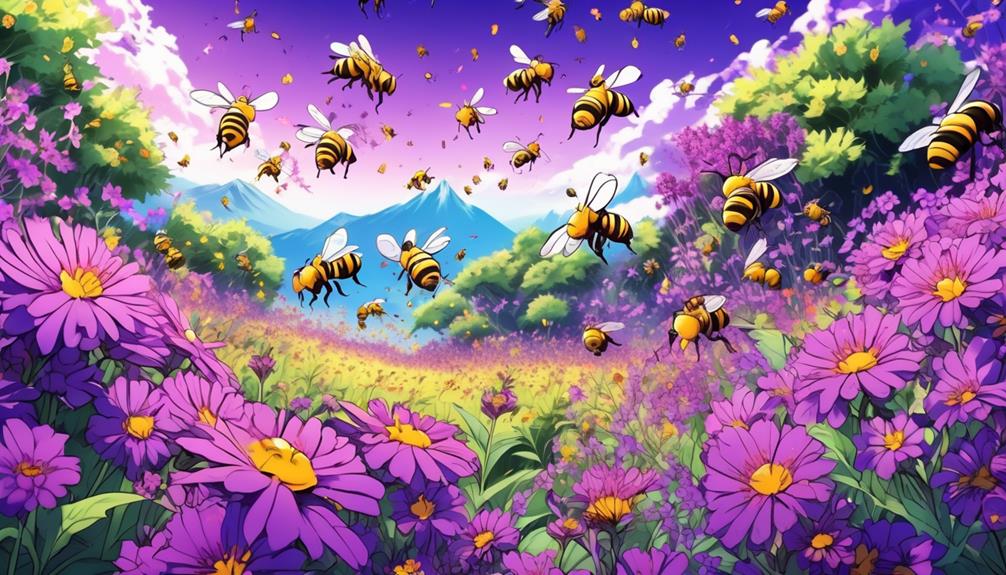
To fully grasp why bees are drawn to verbena, you must first understand the general plant preferences of these industrious pollinators. Bees are attracted to plants that produce large amounts of pollen and nectar, which they need for food. They're also drawn to bright colors, especially blue and yellow, and plants with shallow blossoms that make it easy for them to access the food.
Let's consider this information in a detailed table:
Factors | Description | Examples |
|---|---|---|
Pollen and Nectar | Bees need these for food. Plants with high amounts are attractive. | Sunflowers, clovers |
Colors | Bees are especially attracted to blue and yellow. | Bluebells, daisies |
Blossom Depth | Shallow blossoms make it easy for bees to access nectar and pollen. | Daisies, asters |
These factors combine to create a "perfect storm" of attractiveness in certain plants, like verbena. They're rich in nectar, brightly colored, and have shallow blossoms. You can't blame bees for being drawn to them! Understanding this will help you make your garden more bee-friendly, promoting pollination and supporting these essential creatures.
The Role of Color and Scent
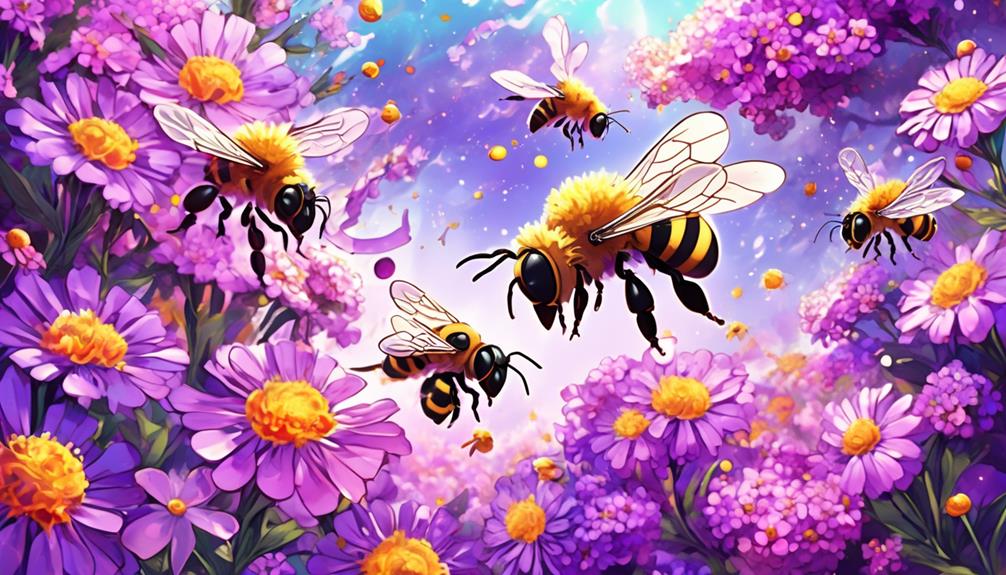
While color plays a crucial role in attracting bees, it's the scent of the plant that truly reels them in. You see, bees, like many insects, are attracted to specific colors. Research shows that they're particularly drawn to blue, purple, and yellow, which explains why they're often seen buzzing around verbenas, lavender, and sunflowers.
But it's not just about the color. The scent of a plant plays a pivotal role in bee attraction. Bees have an incredibly powerful sense of smell, much more potent than ours. They can detect a flower's fragrance from several kilometers away. The scent molecules released by a plant bind to olfactory receptors in the bee's antenna, sending a signal to the brain that something delicious is nearby.
When it comes to verbena, its vibrant purple color and sweet, lemony scent make it a magnet for bees. The plant's scent molecules communicate the presence of nectar, signaling a rich food source. In essence, the color and scent of verbena work synergistically to attract bees, contributing to its pollination and propagation.
Studying Bees' Interaction With Verbena
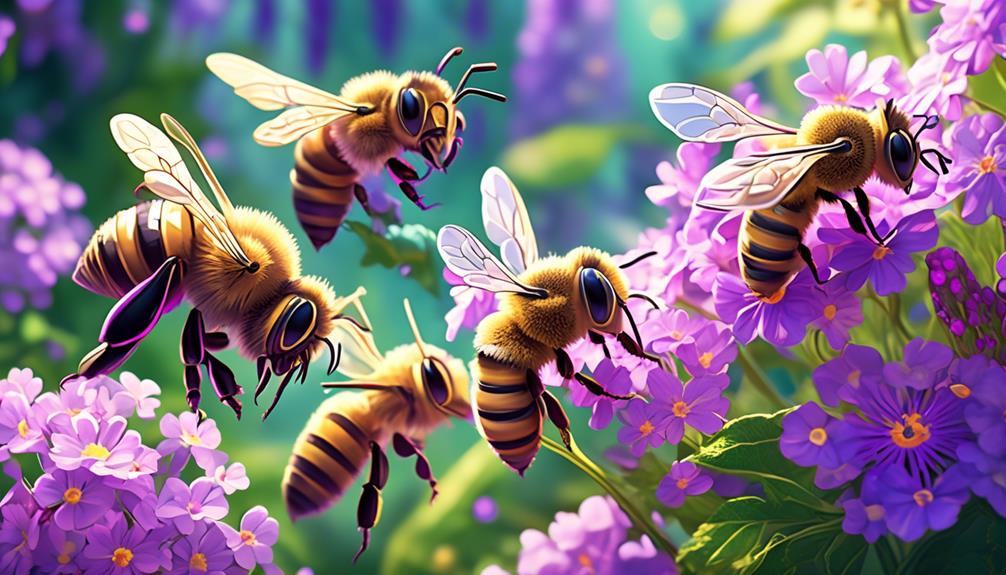
Often, scientists observe bees interacting with verbena to better understand this symbiotic relationship and gain insights into bee behavior and plant pollination strategies. These studies are carried out meticulously, taking into consideration various factors such as the bee's species, the verbena's color, scent, and the environmental context.
Bee Species | Verbena Color |
|---|---|
Honey Bee | Purple |
Bumble Bee | Pink |
Carpenter Bee | White |
Mason Bee | Red |
The table above demonstrates a typical observation. You'll notice that different bee species are attracted to different colors of verbena. This is not a coincidence, but a remarkable outcome of evolution and adaptation. Each species has developed a preference for a certain color, which is usually the one that provides them with the most nectar.
These observations are not just fascinating, they're crucial to our understanding of nature's intricate connections. The more you learn about the symbiotic relationship between bees and verbena, the more you'll appreciate the complexity of our ecosystem. Remember, every interaction, no matter how small, plays a significant role in the grand scheme of things.
Benefits of Verbena for Bees
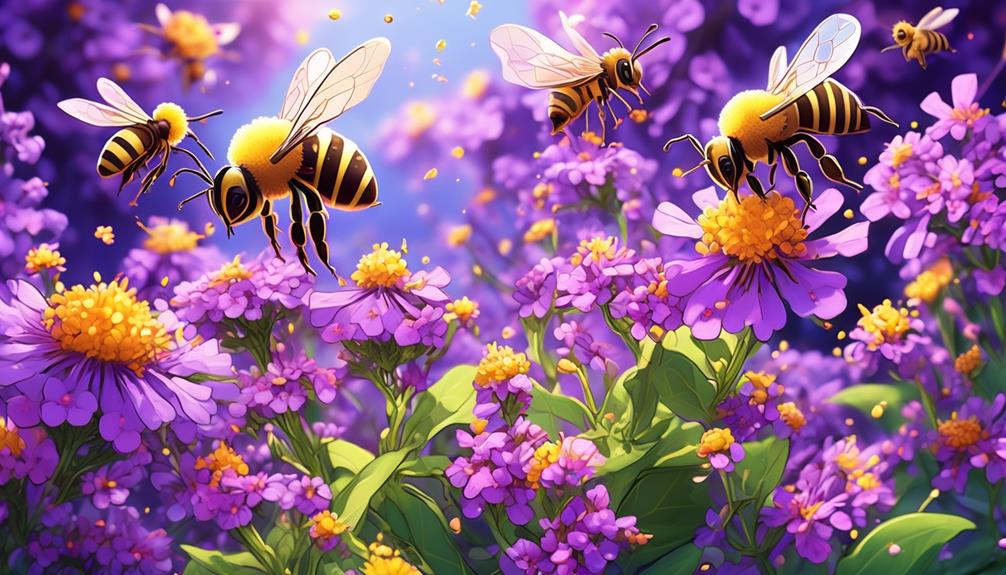
Building on our understanding of the interactions between bees and verbena, let's now explore how this relationship specifically benefits the bees.
Verbena, with its rich nectar, provides a vital food source for bees. This nectar is packed with sugars, which bees convert into energy, and essential amino acids, which play a significant role in bee health and development.
From a more scientific perspective, the nectar of verbena contains sucrose, glucose, and fructose. These simple sugars are easily digestible and provide quick energy for the bees. The abundance of these sugars in verbena nectar makes it particularly attractive to bees.
Verbena also provides pollen, another critical dietary component for bees. Rich in proteins, lipids, vitamins, and minerals, pollen contributes to the growth and development of bee larvae. The microflora in the pollen can even contribute to the bees' gut health, enhancing their immunity and resilience to diseases.
Lastly, verbena's long flowering season ensures a consistent food supply, crucial for bees' survival, especially during seasons when other plants aren't flowering.
In short, verbena doesn't just attract bees – it nourishes them, boosts their health, and aids in their survival.
Enhancing Bee Attraction With Verbena
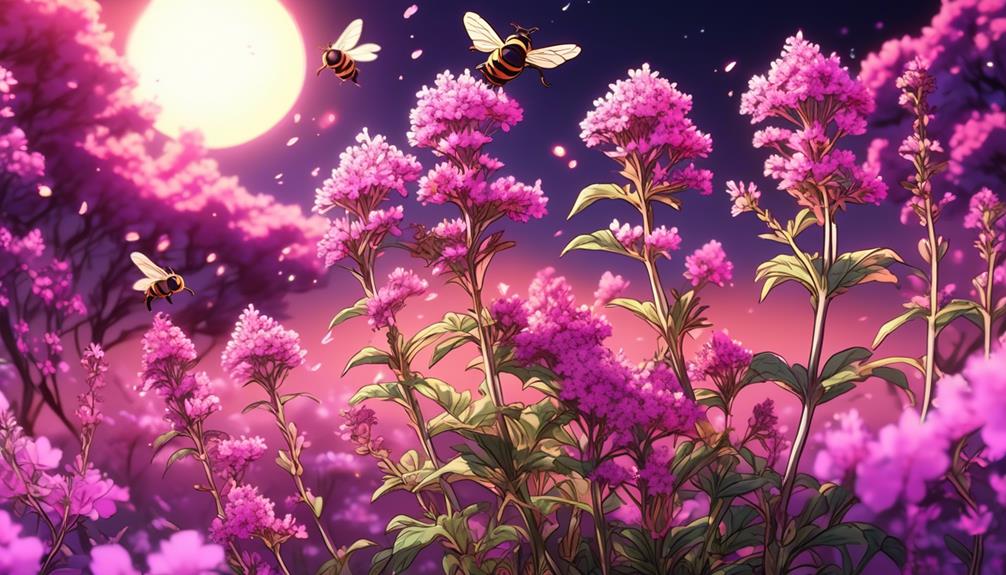
In order to maximize the bee-attracting potential of your garden, incorporating verbena can significantly enhance the appeal due to its rich nectar and long flowering season. Scientifically, bees are attracted to verbena because it's a nectar-rich plant. Its long flowering season, from early summer to the first frost, ensures a continuous food source for the bees.
To augment this attraction, strategically place your verbena plants. Bees have a strong sense of smell and prefer clusters of same species plants. Planting verbena in groups can increase their visibility and scent, thus luring more bees.
But, remember, bees can't see the same spectrum of colors humans do. They're most attracted to blue, purple, and yellow. Luckily, verbena flowers come in these bee-friendly colors.
Further, consider the condition of your soil. Verbena needs well-drained soil to thrive. Regular watering and a sunny location also promote healthy, bee-attracting flowers. However, avoid using pesticides or any chemical treatments that could be harmful to bees.
Frequently Asked Questions
Are There Any Specific Types of Verbena That Bees Are More Attracted To?
Yes, there are specific types of verbena that bees prefer. Bees are particularly attracted to purpletop vervain (Verbena bonariensis) and moss verbena (Verbena tenuisecta).
They're enticed by the vibrant colors and sweet nectar of these plants. You'll often see bees buzzing around these varieties in your garden.
Can Planting Verbena in Your Garden Help Increase the Local Bee Population?
Yes, planting verbena in your garden can help increase the local bee population. Its vibrant colors and sweet nectar are highly attractive to bees.
As a nectar-rich plant, verbena serves as a food source, encouraging more bees to visit and stay in your garden.
You're not only beautifying your space but also actively contributing to bee conservation efforts.
Are There Any Other Insects That Are Attracted to Verbena?
Yes, there are indeed other insects attracted to Verbena. You'll often find butterflies and hummingbirds flocking to these vibrant flowers. Additionally, moths, ladybugs, and even some beetles are known to visit Verbena.
It's not just about the nectar for these critters. They're also drawn to the pollen, which provides essential nutrients.
Is Verbena Harmful to Bees in Any Way?
No, verbena isn't harmful to bees. In fact, you'll often see bees buzzing around these plants. They're attracted to verbena's bright, abundant flowers and the nectar they provide.
Not only is verbena safe for bees, but it's also beneficial. It helps bees by providing them with a rich food source and, in return, the bees aid in the plant's pollination.
It's a win-win situation for both parties.
How Does the Climate or Region Affect a Bee's Attraction to Verbena?
Sure, climate or region can impact a bee's attraction to verbena. In temperate climates, verbena's long flowering period provides bees with nectar over an extended period.
But, if you're in a region with harsh winters, verbena may not thrive, reducing its attractiveness to bees.
Also, bees prefer areas with diverse plant life, so if verbena's the only plant around, they mightn't be as attracted.
It really depends on a balance of factors.
Conclusion
Indeed, bees do like verbena. Its vibrant colors and appealing scent make it an attractive stop in a bee's daily foraging. The plant's nectar provides vital nutrients, supporting the bee population.
Moreover, incorporating verbena into your garden doesn't just benefit bees, it enhances biodiversity. By understanding the science behind bees' attraction to verbena, we can make informed decisions to support these vital pollinators.
So, why not consider adding some verbena to your garden today?

